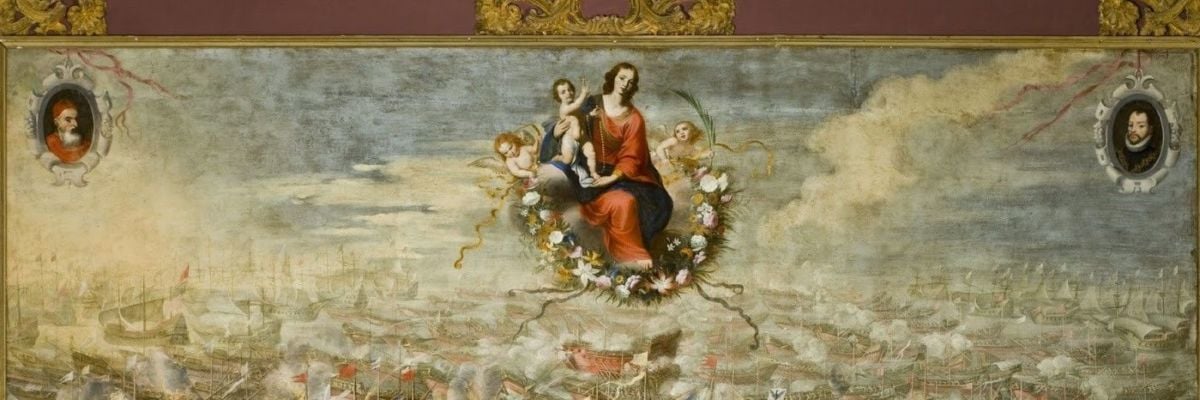
The year 1571 is not well known to Americans. October 7, the Feast of Our Lady of the Rosary, celebrates the victory at Lepanto in that year—the most important naval contest in human history, and the battle that saved the Christian West from defeat at the hands of the Ottoman Turks.
That this military triumph is also a Marian feast underscores our image of the Blessed Virgin prefigured in the Canticle of Canticles: “Who is she that cometh forth as the morning rising, fair as the moon, bright as the sun, terrible as an army set in array?”
In a papacy of great achievements, the greatest for Pope St. Pius V came on March 7, 1571, on the feast of his fellow Dominican, St. Thomas Aquinas. At the Dominican Church of Santa Maria Sopra Minerva in Rome, Pope Pius formed the Holy League. Genoa, the Papal States, and the Kingdom of Spain put aside their jealousies and pledged to assemble a fleet capable of confronting Sultan Selim II’s war galleys before the east coast of Italy became the next front in the war between the Christianity and Islam.
The day was not a total triumph, though. Venice at first refused to join, and the rest of Europe ignored Pius’s call for a new crusade. But as the pope prayed for Venice to answer a higher call, a new breed of fiery priests led by stirring preachers like St. Francisco Borgia, superior general of the Jesuits, inflamed the hearts of Christian Europeans throughout the Mediterranean with their sermons against Islam. Enough Venetians must have been listening, because on May 25, Venice at last joined the Holy League. By fits and starts, with hesitation and quarreling on the part of a few of the principal players, the fleet of the Holy League was forming.
The man chosen by Pius V to serve as captain general of the Holy League did not falter: Don John of Austria, the illegitimate son of the late Holy Roman Emperor, Charles V, and half-brother of Philip II, king of Spain. The young commander had distinguished himself in combat against Barbary corsairs and in the Morisco rebellion in Spain, a campaign in which he demonstrated his capacity for swift violence when the threat called for it and restraint when charity demanded it. He was twenty-four years old.
Taking the young warrior by the shoulders, Pius V looked Don John of Austria in the eye and declared, “The Turks, swollen by their victories, will wish to take on our fleet, and God—I have the pious presentiment—will give us victory. Charles V gave you life. I will give you honor and greatness. Go and seek them out!”
Of the 206 galleys and 76 smaller boats that constituted the Holy League fleet, more than half came from Venice. The next largest contingent came from Spain and included galleys from Sicily, Naples, Portugal, and Genoa, the latter owned by the Genovese condottiere admiral, Gianandrea Doria. The balance of the galleys came from the Holy See.
Don John took charge of his fleet and promptly forbade women from coming aboard the galleys. He declared that blasphemy among the crews would be punishable by death. The whole fleet followed his example and made a three-day fast.
By September 28, the Holy League had made its way across the Adriatic Sea and was anchored between the west coast of Greece and the island of Corfu. By this time, news of the Turks’ horrifying murder of the Venetian governor, Marcantonio Bragadino, had reached the Holy League, and the Venetians were determined to settle the score. Don John reminded his fleet that the battle they would soon engage in was as much spiritual as physical.
Pius V had granted a plenary indulgence to the soldiers and crews of the Holy League. Priests of the great orders, Franciscans, Capuchins, Dominicans, Theatines, and Jesuits, were stationed on the decks of the Holy League’s galleys, offering Mass and hearing confessions. Many of the men who rowed the Christian galleys were criminals. Don John ordered them all unchained, and he issued them each a weapon, promising them their freedom if they fought bravely. He then gave every man in his fleet another weapon more powerful than anything the Turks could muster: a rosary.
On the eve of battle, the men of the Holy League prepared their souls by falling to their knees on the decks of their galleys and praying the rosary. Back in Rome, and up and down the Italian peninsula, at the behest of Pius V, the churches were filled with the faithful telling their beads. In heaven, the Blessed Mother, her Immaculate Heart aflame, was listening.
At dawn on October 7, 1571, the Holy League rowed down the west coast of Greece and turned east into the Gulf of Patras. When the morning mist cleared, the Christians, rowing directly against the wind, saw the squadrons of the larger Ottoman fleet arrayed like a crescent from shore to shore, bearing down on them under full sail.
As the fleets grew closer, the Christians could hear the gongs and cymbals, drums and cries of the Turks. The men of the Holy League quietly pulled at their oars; the soldiers stood on the decks in silent prayer. Priests holding large crucifixes marched up and down the decks, exhorting the men to be brave and hearing final confessions.
Then the Blessed Virgin intervened.
The wind shifted 180 degrees. The sails of the Holy League were filled with the divine breath, driving them into battle. Now heading directly into the wind, the Turks were forced to strike their sails. The tens of thousands of Christian galley slaves who rowed the Turkish vessels felt the sharp sting of the lash, summoning them up from under their benches and demanding they take hold of their oars and pull against the wind.
Don John knelt on the prow of his flagship, Real, and said a final prayer. Then he stood and gave the order for the Holy League’s battle standard, a gift from Pius V, to be unfurled. Christians up and down the battle line cheered as they saw the giant blue banner, bearing an image of our crucified Lord.
The fleets engaged at midday. The first fighting began along the Holy League’s left flank, commanded by the Venetian admiral Agostin Barbarigo, where many of the smaller, swifter Turkish galleys were able to maneuver around the inshore flank. Barbarigo responded with a near impossibility: he pivoted his entire squadron, fifty-four ships, counterclockwise and began to pin the Turkish right flank, commanded by Mehemet Sirrocco, against the north shore of the Gulf of Patras. Gaps formed in Barbarigo’s line, and Ottoman galleys broke into the intervals. As galley pulled up along galley, the slaughter brought on by cannon, musket ball, and arrow was horrific, but the Venetians in time prevailed. Barbarigo took an arrow to the eye. Before he died, he learned of the death of Sirrocco and the crushing defeat of the Turkish right line.
In the center of the battle, breaking a convention of naval warfare, the opposing flagships engaged—Don John’s Real with Muezzinzade Ali Pasha’s Sultana. Twice Spanish infantry boarded and drove the Sultana’s Janissaries back to the mast, and twice they were driven back to the Real by Ottoman reinforcements. Don John led the third charge across Sultana’s bloodied deck. He was wounded in the leg, but Ali Pasha took a musket ball to the forehead. One of Real’s freed convicts lopped off the Turkish admiral’s head and held it aloft on a pike. The Muslims’ sacred banner, with the name of Allah stitched in gold calligraphy 28,900 times, which Islamic tradition held was carried in battle by the Prophet, was captured by the Christians. Terror struck the Turks, but the fight was far from won.
On the Holy League’s right flank, Doria was forced to increase the intervals between his galleys to keep his line from being flanked on the south by the larger Ottoman squadron, under the command of the Algerian Uluch Ali. When the space between Doria’s squadron and Don John’s grew large enough, Uluch Ali sent his corsairs through the gap to envelop the galleys of Don John’s squadron from behind. Don Alvaro de Bazan, commanding the Holy League’s reserve squadron of thirty-five galleys, had carefully kept his ships out of the fray until the moment came when he was most needed. Now he entered the fight, rescuing the center of the Holy League from the Turkish vessels that had surrounded them before turning his squadron south to aid the outmanned Doria.
The fighting lasted for five hours. The sides were evenly matched and well led, but the Divine favored the Christians, and once the battle turned in their favor, it became a rout. All but thirteen of the nearly 300 Turkish vessels were captured or sunk, and over 30,000 Turks were slain. Not until the First World War would the world again witness such carnage in a single day’s fighting. In the aftermath of the battle, the Christians gave no quarter, making sure to kill the helmsmen, galley captains, archers, and Janissaries. The sultan could rebuild ships, but without these men, it would be years before he would be able to use them.
The news of the victory made its way back to Rome, but the pope was already rejoicing. On the day of the battle, Pius had been consulting with his cardinals at the Dominican Basilica of Santa Sabina on the Aventine Hill. He paused in the midst of their deliberations to look out the window. Up in the sky, the Blessed Mother favored him with a vision of the victory. Turning to his cardinals, he said, “Let us set aside business and fall on our knees in thanksgiving to God, for he has given our fleet a great victory.”
This article is adapted from “The Battle that Saved the Christian West,” originally published in Catholic Answers Magazine on March 1, 2007. Christopher Check’s original article, which goes into riveting detail about the Battle of Lepanto and the events leading to it, has been immensely popular over the years and should be read (or re-read) in full.
Image: Juan de Toledo y Mateo Gilarte via Wikimedia Commons, CC BY-SA 4.0 (cropped).



